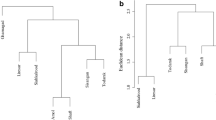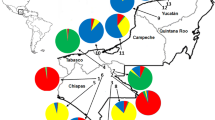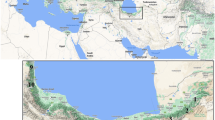Abstract
The main goal of this contribution is to investigate the genetic structure of boll weevil populations from South America (Argentina and Brazil) and to make further comparisons with a putative source population from USA. Samples were collected in a Paranaense forest under reserve protection, cotton fields and non-cultivated areas. Data from anonymous molecular markers were analysed using both traditional methods of population genetics and Bayesian approaches. Results help to support a previous hypothesis on the presence of two lineages of boll weevil populations in South America: one with characteristics of recent invaders and the other with characteristics of ancient populations. The sample from Urugua-í Provincial Park (Misiones, Argentina) shows the highest percentage of polymorphic loci, the highest values of mean heterozigosity, and the largest number of population-specific alleles, all being typical features of ancient populations. Furthermore, the Urugua-í sample shows two gene pools occurring in sympatry, probably as a consequence of a secondary contact. The remaining samples reveal not only lower percentages of polymorphic loci and heterozygosity values, but also an almost negligible presence of specific alleles. Bayesian methods also suggest the occasional migration of some individuals of ancient lineages from their natural habitats in fragments of the Paranaense forest into cotton fields, and vice versa.




Similar content being viewed by others
References
Avise JC, Walker D (1998) Pleistocene phylogeographic effects on avian populations and the speciation process. P Roy Soc Lond B Bio 65:457–463
Baus E, Darrock DJ, Bruford MW (2005) Gene flow patterns in Atlantic and Mediterranean populations of the Lusitanian sea star Asterina gibbosa. Mol Ecol 14:3373–3382
Bibby CJ, Collar NJ, Crosby MJ, Gead MJ, Ch Imboden, Johnson TH, Stattersfield AJ, Thirgood SJ (1992) Putting biodiversity on the map: priority areas for global conservation. ICBP International Council for Bird Preservation, Cambridge, U.K
Black WC (1997) RAPDBIOS 3.0, RAPDIST, RAPDFST, RAPDPLOT 3.0. Department of Microbiology, Colorado State University, Fort Collins, CO
Burke HR, Cate JR (1979) A new species of Mexican Anthonomus related to the boll weevil (Coleoptera: Curculionidae). Ann Entomol Soc Am 72:189–192
Burke HR, Clark WE, Cate JR, Fryxell PA (1986) Origin and dispersal of the boll weevil. Bull Entomol Soc Am 32:228–238
Cabrera AL, Willink A (1980) Biogeografía de América Latina. 2nd edition. Serie de Biología. Sec. Gral. OEA, Washington, D. C
Confalonieri, VA., Scataglini MA., Lanteri AA. (2003) Origen de las poblaciones del picudo del algodonero en Argentina, Brasil y Paraguay: una hipótesis basada en el estudio de genes mitocondriales. Proceedings Cotton in the Southern Cone. Project Integrated Pest Management of the Cotton Boll Weevil in Argentina, Brazil and Paraguay. CFC/ICAC/04. Final Workshop Part I: 29–39. Argentina
Felsenstein J (1993) PHYLIP (Phylogeny inference package) Version 3.5C. Department of Genetics, The University of Washington, Seattle, WA
Fryxell PA, Lukefahr MJ (1967) Hampea Schlecht: possible primary host of the boll weevil. Science 155:1568–1569
Holsinger KE, Lewis PO, Dipak KD (2002) A Bayesian approach to inferring population structure from dominant markers. Mol Ecol 11:1157–1164
Hu J, Quiros CF (1995) Generation of DNA-based markers in specific genome regions by two primer RAPD reactions. PCR Methods Appl 4:346–351
Jones RW (2001) Evolution of the host plant association of the Anthonomus grandis species group (Coleoptera: Curculionidae): phylogenetic test of various hypothesis. Ann Entomol Soc Am 94(1): 51–58
Jones RW, Burke HR (1997) New species and host plants of the Anthonomus grandis species group (Coleoptera: Curculionidae). Proc Entomol Soc Wash 99(4): 705–719
Kim KS, Sappington TW (2004) Genetic structuring of boll weevil populations in the US based on RAPD markers. Insect Mol Biol 13(3): 293–303
Krapovickas, A. (2000) El género Cienfuegosia y el picudo del algodonero al sur del trópico, en Sudamérica. III International Workshop on Integrated Pest Management of the Cotton Boll Weevil in Argentina, Brasil and Paraguay, Workshop Proceedings p. 43
Laclau P (1994) La Conservación de los Recursos Naturales y el Hombre en la Selva Paranaense. Boletín Técnico de la Fundación Vida Silvestre Argentina
Lanteri AA (1999) Aplicación de técnicas moleculares en estudios poblacionales y filogenéticos en Curculionidae. Rev Soc Entomol Argent 58(1–2): 161–168
Lanteri AA, Confalonieri VA, Scataglini MA (2003) El picudo del algodonero en la Argentina: Principales resultados e implicancias de los estudios moleculares. Rev Soc Entomol Argent 62(3–4): 1–15
Lynch M, Milligan BG (1994) Analysis of populations genetic structure with RAPD analysis. Mol Ecol 3:91–100
Manessi OG (1997) Anthonomus grandis Boh. El picudo del algodonero. La super plaga. FULCPA, Buenos Aires
Nei M. (1972) Genetics distances between populations. Am Nat 106:203–208
Pritchard JK, M Stephans, Donnelly P (2000) Inference of population structure using multilocus genotypes data. Genetics 155:945–959
Reiss RA, Schwert DP, Ashworth AC (1995) Field preservation of Coleoptera for molecular genetic analyses. Environ Entomol 24(3): 716–719
Roehrdanz RL (2001) Genetic differentiation of Southeastern boll weevil and Thurberia weevil populations of Anthonomus grandis (Coleoptera: Curculionidae) using mitochondrial DNA. Ann Entomol Soc Am 94(6): 928–935
Roehrdanz RL, North DT (1992) Mitochondrial DNA restriction fragments variation and biosystematics of the boll weevil, Anthonomus grandis. Southwest Entomol 17(2): 101–108
Saitou N, Nei M (1987) The Neighbor-joining method: a new method for reconstructing phylogenetic trees. Mol Biol Evol 4:406–425
Sall T, Lind-Hallden C, Hallden C (2000) Primer mixture in RAPD analysis. Hereditas 133:203–208
Scataglini MA, Confalonieri VA, Lanteri AA (2000) Dispersal of the boll weevil (Coleoptera: Curculionidae) in South America: evidence of RAPD analysis. Genetica 108:127–136
Scataglini MA, Lanteri AA, Confalonieri VA (2006) Diversity of boll weevil populations in South America: a phylogeographic approach. Genetica 126:353–362
Swofford DL, Selander RB (1981) Biosys−1: a fortran program for the comprehensive analysis of electrophoretic data in population genetics and systematics. J Heredity 72:81–283
Spiegelhalter DJ, Best NG, Carlin BP, van der Linde A (2002) Bayesian measures of model complexity and fit. J Roy Stat Soc SerieB 64:483–689
Townsend CHT (1895) Report of the Mexican boll weevil in Texas (Anthonomus grandis Boh.). Insect Life 7:295–309
Weir BS, Cockerham CC (1984) Estimating F-statistics for the analysis of population structure. Evolution 38:1358–1370
Welsh J, McClelland M (1990) Fingerprinting genomes using PCR with arbitrary primers. Nucl Acids Res 18:7213–7218
Zhivotovsky LA (1999) Estimating population structure in diploids with multilocus dominant DNA markers. Mol Ecol 8:907–913
Acknowledgements
This work was supported by grants from the Argentina’s National Research Council (CONICET), the University of Buenos Aires.
Author information
Authors and Affiliations
Corresponding author
Rights and permissions
About this article
Cite this article
Guzmán, N.V., Lia, V.V., Lanteri, A.A. et al. Population structure of the boll weevil in cotton fields and subtropical forests of South America: a bayesian approach. Genetica 131, 11–20 (2007). https://doi.org/10.1007/s10709-006-9108-3
Received:
Accepted:
Published:
Issue Date:
DOI: https://doi.org/10.1007/s10709-006-9108-3




